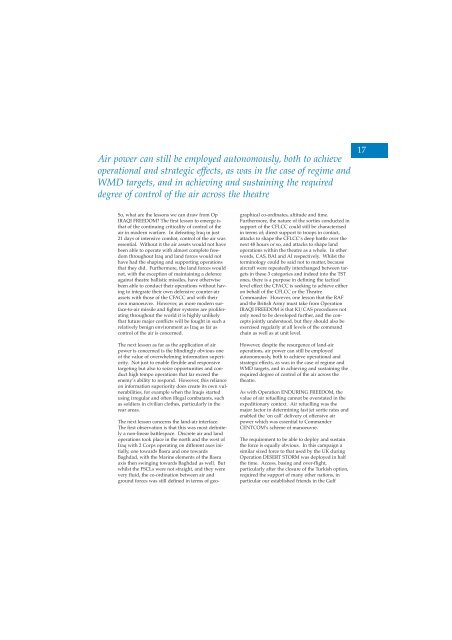Volume 6 No 4 - Royal Air Force Centre for Air Power Studies
Volume 6 No 4 - Royal Air Force Centre for Air Power Studies
Volume 6 No 4 - Royal Air Force Centre for Air Power Studies
Create successful ePaper yourself
Turn your PDF publications into a flip-book with our unique Google optimized e-Paper software.
<strong>Air</strong> power can still be employed autonomously, both to achieve<br />
operational and strategic effects, as was in the case of regime and<br />
WMD targets, and in achieving and sustaining the required<br />
degree of control of the air across the theatre<br />
17<br />
So, what are the lessons we can draw from Op<br />
IRAQI FREEDOM? The first lesson to emerge is<br />
that of the continuing criticality of control of the<br />
air in modern warfare. In defeating Iraq in just<br />
21 days of intensive combat, control of the air was<br />
essential. Without it the air assets would not have<br />
been able to operate with almost complete freedom<br />
throughout Iraq and land <strong>for</strong>ces would not<br />
have had the shaping and supporting operations<br />
that they did. Furthermore, the land <strong>for</strong>ces would<br />
not, with the exception of maintaining a defence<br />
against theatre ballistic missiles, have otherwise<br />
been able to conduct their operations without having<br />
to integrate their own defensive counter-air<br />
assets with those of the CFACC and with their<br />
own manoeuvre. However, as more modern surface-to-air<br />
missile and fighter systems are proliferating<br />
throughout the world it is highly unlikely<br />
that future major conflicts will be fought in such a<br />
relatively benign environment as Iraq as far as<br />
control of the air is concerned.<br />
The next lesson as far as the application of air<br />
power is concerned is the blindingly obvious one<br />
of the value of overwhelming in<strong>for</strong>mation superiority.<br />
<strong>No</strong>t just to enable flexible and responsive<br />
targeting but also to seize opportunities and conduct<br />
high tempo operations that far exceed the<br />
enemy’s ability to respond. However, this reliance<br />
on in<strong>for</strong>mation superiority does create its own vulnerabilities,<br />
<strong>for</strong> example when the Iraqis started<br />
using irregular and often illegal combatants, such<br />
as soldiers in civilian clothes, particularly in the<br />
rear areas.<br />
The next lesson concerns the land-air interface.<br />
The first observation is that this was most definitely<br />
a non-linear battlespace. Discrete air and land<br />
operations took place in the north and the west of<br />
Iraq with 2 Corps operating on different axes initially,<br />
one towards Basra and one towards<br />
Baghdad, with the Marine elements of the Basra<br />
axis then swinging towards Baghdad as well. But<br />
whilst the FSCLs were not straight, and they were<br />
very fluid, the co-ordination between air and<br />
ground <strong>for</strong>ces was still defined in terms of geographical<br />
co-ordinates, altitude and time.<br />
Furthermore, the nature of the sorties conducted in<br />
support of the CFLCC could still be characterised<br />
in terms of; direct support to troops in contact,<br />
attacks to shape the CFLCC’s deep battle over the<br />
next 48 hours or so, and attacks to shape land<br />
operations within the theatre as a whole. In other<br />
words, CAS, BAI and AI respectively. Whilst the<br />
terminology could be said not to matter, because<br />
aircraft were repeatedly interchanged between targets<br />
in these 3 categories and indeed into the TST<br />
ones, there is a purpose in defining the tactical<br />
level effect the CFACC is seeking to achieve either<br />
on behalf of the CFLCC or the Theatre<br />
Commander. However, one lesson that the RAF<br />
and the British Army must take from Operation<br />
IRAQI FREEDOM is that KI/CAS procedures not<br />
only need to be developed further, and the concepts<br />
jointly understood, but they should also be<br />
exercised regularly at all levels of the command<br />
chain as well as at unit level.<br />
However, despite the resurgence of land-air<br />
operations, air power can still be employed<br />
autonomously, both to achieve operational and<br />
strategic effects, as was in the case of regime and<br />
WMD targets, and in achieving and sustaining the<br />
required degree of control of the air across the<br />
theatre.<br />
As with Operation ENDURING FREEDOM, the<br />
value of air refuelling cannot be overstated in the<br />
expeditionary context. <strong>Air</strong> refuelling was the<br />
major factor in determining fast jet sortie rates and<br />
enabled the ‘on call’ delivery of offensive air<br />
power which was essential to Commander<br />
CENTCOM’s scheme of manoeuvre.<br />
The requirement to be able to deploy and sustain<br />
the <strong>for</strong>ce is equally obvious. In this campaign a<br />
similar sized <strong>for</strong>ce to that used by the UK during<br />
Operation DESERT STORM was deployed in half<br />
the time. Access, basing and over-flight,<br />
particularly after the closure of the Turkish option,<br />
required the support of many other nations, in<br />
particular our established friends in the Gulf
















